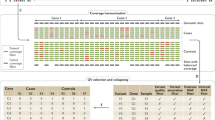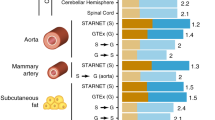ABSTRACT
Differential drug response, that is, pharmacodynamics, is most often likely to be a complex trait, controlled by the combined influences of multiple genes and environmental influences. Genetic mapping has proven to be a powerful tool for detecting and identifying specific genes affecting complex traits, that is, quantitative trait loci (QTL), based on polymorphic markers. In this article, we present a novel statistical model for genetic mapping of QTL governing pharmacodynamic processes. In principle, this model is a combination of functional mapping proposed to map function-valued traits and linkage disequilibrium mapping designed to provide high-resolution mapping of QTL by making use of recombination events created at a historic time. We implement a closed-form solution for the Expectation-Maximization algorithm to estimate the population genetic parameters of QTL and the simplex algorithm to estimate the curve parameters describing the pharmacodynamic changes of different QTL genotypes in response to drug dose or concentrations. Extensive simulations are performed to investigate the statistical properties of our model. The implications of our model in pharmacogenetic and pharmacogenomic research are discussed.
This is a preview of subscription content, access via your institution
Access options
Subscribe to this journal
Receive 6 print issues and online access
$259.00 per year
only $43.17 per issue
Buy this article
- Purchase on Springer Link
- Instant access to full article PDF
Prices may be subject to local taxes which are calculated during checkout

Similar content being viewed by others
References
Nebert DW . Polymorphisms in drug-metabolizing enzymes: what is their clinical relevance and why do they exist? Am J Hum Genet 1997; 60: 265–271.
Evans WE, Relling MV . Pharmacogenomics: translating functional genomics into rational therapeutics. Science 1999; 286: 487–491.
Evans WE, Johnson JA . Pharmacogenomics: the inherited basis for interindividual differences in drug response. Annu Rev Genomics Hum Genet 2001; 2: 9–39.
Watters JW, McLeod HL . Using genome-wide mapping in the mouse to identify genes that influence drug response. Trends Pharmacolog Sci 2003; 24: 55–58.
Wu RL, Ma C-X, Chang M, Littell RC, Wu SS, Yin TM et al. A logistic mixture model for characterizing genetic determinants causing differentiation in growth trajectories. Genet Res 2002; 19: 235–245.
Wu RL, Ma C-X, Yang MCK, Chang M, Santra U, Wu SS et al. Quantitative trait loci for growth in Populus. Genet Res 2003; 81: 51–64.
Wu RL, Ma C-X, Zhao W, Casella G . Functional mapping of quantitative trait loci underlying growth rates: a parametric model. Physiol Genomics 2003; 14: 241–249.
Wu RL, Ma C-X, Lin M, Casella G . A general framework for analyzing the genetic architecture of developmental characteristics. Genetics 2004; 166: 1541–1551.
Wu RL, Ma C-X, Lin M, Wang Z, Casella G . Functional mapping of quantitative trait loci underlying growth trajectories using a transform-both-sides logistic model. Biometrics 2004; 60: 729–738.
Ma C-X, Casella G, Wu RL . Functional mapping of quantitative trait loci underlying the character process: a theoretical framework. Genetics 2002; 161: 1751–1762.
Wu RL, Casella G . Statistical Genomics of Complex Traits: A Quantitative Trait Loci Perspective. Springer: New York 2005; (in press).
Lou X-Y, Casella G, Littell RC, Yang MKC, Wu RL . A haplotype-based algorithm for multilocus linkage disequilibrium mapping of quantitative trait loci with epistasis in natural populations. Genetics 2003; 163: 1533–1548.
Giraldo J . Empirical models and Hill coefficients. Trends Pharmacolog Sci 2003; 24: 63–65.
Lander ES, Botstein D . Mapping Mendelian factors underlying quantitative traits using RELP linkage maps. Genetics 1989; 121: 185–199.
Wu RL, Ma C-X, Casella G . Joint linkage and linkage disequilibrium mapping of quantitative trait loci in natural populations. Genetics 2002; 160: 779–792.
Carroll RJ, Ruppert D . Power-transformations when fitting theoretical models to data. J Am Stat Assoc 1984; 79: 321–328.
Zhao W, Wu RL, Ma C-X, Casella G . A fast algorithm for functional mapping of complex traits. Genetics 2004; (accepted).
Nelder JA, Mead R . A simplex method for function minimization. Computer J 1965; 7: 308–313.
Churchill GA, Doerge RW . Empirical threshold values for quantitative trait mapping. Genetics 1994; 138: 963–971.
Lynch M, Walsh B . Genetics and Analysis of Quantitative Traits. Sinauer: Sunderland, MA 1998.
Sowinski KM, Burlew BS, Johnson JA . Racial differences in sensitivity to the negative chronotropic effects of propranolol in healthy men. Clin Pharm Therap 1995; 57: 678–683.
Wilson JF, Weale ME, Smith AC, Gratrix F, Fletcher B, Thomas MG et al. Population genetic structure of variable drug response. Nat Genet 2001; 29: 265–269.
Kruglyak L . Prospects for whole-genome linkage disequilibrium mapping of common disease genes. Nat Genet 1999; 22: 139–144.
Author information
Authors and Affiliations
Corresponding author
Rights and permissions
About this article
Cite this article
Gong, Y., Wang, Z., Liu, T. et al. A statistical model for functional mapping of quantitative trait loci regulating drug response. Pharmacogenomics J 4, 315–321 (2004). https://doi.org/10.1038/sj.tpj.6500262
Received:
Revised:
Accepted:
Published:
Issue Date:
DOI: https://doi.org/10.1038/sj.tpj.6500262
Keywords
This article is cited by
-
Pharmacodynamic genome-wide association study identifies new responsive loci for glucocorticoid intervention in asthma
The Pharmacogenomics Journal (2015)
-
Functional mapping — how to map and study the genetic architecture of dynamic complex traits
Nature Reviews Genetics (2006)
-
Sequencing drug response with HapMap
The Pharmacogenomics Journal (2005)



